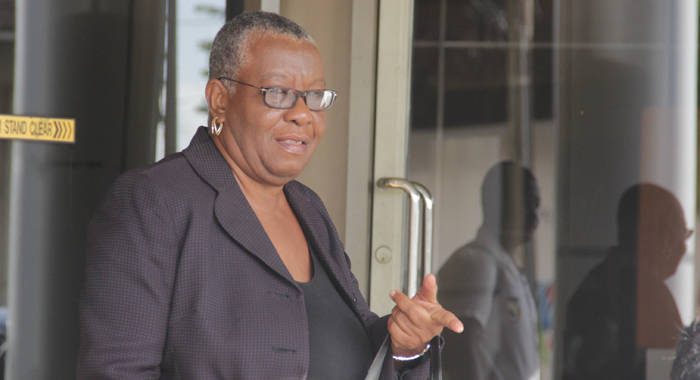Election officials used “stickers” and “labels” in the 2015 general elections rather than the “seal” mandated by law.
This was revealed by then supervisor of elections, Sylvia Findlay-Scrubb as she was cross examined on Thursday.
Rule 41(7) of the House of Assembly Election Rules says: “The presiding officer shall make the necessary number of copies of the statement of the poll in Form 16 in the Appendix, one copy to be retained by the presiding officer, and one copy for the returning officer which shall be enclosed in a special envelope supplied for the purpose, which envelope he shall seal and deliver personally or transmit to the returning officer.”
41(8) says, “… The ballot box shall then be locked and sealed with the seal of the presiding officer and forthwith transmitted or delivered to the returning officer…”
During his cross examination of the witness, lead lawyer for the petitioners, Queen’s Counsel Stanley “Stalky” John asked Findlay-Scrubb if any seal was provided for the envelopes.
“Do you recall providing that seal?” John asked Findlay-Scrubb.
She said a seal is provided, as required in 41(8).
“When 7 spoke of the special envelope in which form 16 is placed, ‘which envelope he shall seal and deliver’, we do not understand that to be a seal as for ‘8’, where you seal, you close that envelope and give it — to seal it as in closing the envelope, make sure that the envelope is not open and give it – that is given separately to the returning officer.”
The judge, Justice Stanley John, asked if seven means closing the envelope, “closing it in whatever way”, as distinct from “8”, “where something is being asked”.
Counsel John then went on to ask the former election chief if the sealing of the envelope in rule 47(8) is the same type of seal or if there is a different seal.
Findlay-Scrubb pointed the court to where 47(8) says “… and this envelope”, which she said contains all the election documents, “shall then be sealed and placed in the ballot box”.
The former elections chief said that again, “‘seal’ there is interpreted as seal, the way you seal an envelope, as in closing the envelope”.
In response to Counsel John’s question about whether there is an embossed stamp of anything like that, Findlay-Scrubb said no.
“We come to that later,” she said.
“I see,” said counsel John.
“That envelope can be opened and closed just by putting on any sticker – in the ordinary way that one can open an envelope and stick it back,” counsel John said.
The former elections chief said that the envelope has glue on it.
“It is one of the large manila envelopes that we use. So then you have to use glue and seal that — stick it down and put it into the box.”
Counsel John then noted that the rule says
Findlay-Scrubb said this is where electoral officials “actually have a seal”.
She said that in different documents it is called different things, adding that it is called “a label”.
Counsel John interjected, “Well, actually, you referred to it as a sticker.”
He said that Findlay-Scrubb had referred to it as a sticker, and that was “rather interesting… because the law says seal”.
In her testimony, Findlay-Scrubb said that her office had used plastic ballot boxes in the election although she said the law intended for wooden boxes to be used.
In her witness statement, the former supervisor of elections says:
“In addition to the plastic ties, a sticker or label is provided to the various presiding officers to that they can, along with relevant, agents and poll clerks, can affix their signatures. The sticker or label is for identification purposes and for confirming that all ballots, counterfoils and stubs were placed in sealed envelopes in the ballot box.”
Counsel John said that it seems to him that based on Findlay-Scrub’s evidence that, firstly, there is a sticker or label for the envelope.
Findlay-Scrubb said that was not the case.
“Closed envelope. Sealed, meaning closed,” she told the court.
Asked how the sticker or label would confirm that “all ballots, counterfoils and stubs were placed in sealed envelopes in the ballot box”, Findlay-Scrubb said:
“When the Representation of the People’s Act spoke of sealing the boxes, the act was … clearly that it was the wooden boxes that we used up until the election of 2005.”
Findlay-Scrubb said that by the time she had conducted the referendum of 2009, a new plastic box, “used internationally” was introduced into the local system.
She said that the decision to acquire plastic ballot boxes was made before she became supervisor of elections.
“And so it was not possible to seal the plastic boxes in the same way that the wooden boxes were sealed. Therefore, that’s where the plastic ties come in. They, fundamentally, replaced the key that would have been used to lock the wooden boxes,” she told the court.
Benjamin “Ben” Exeter and Lauron Baptiste of the main opposition New Democratic Party have brought the petitions challenging the announced victories of Sir Louis Straker and Montgomery Daniel of the Unity Labour Party in Central Leeward and North Windward in the 2015 general elections.
Election officials say that the ULP won eight of the 15 seats while the remaining seven went to the NDP.
The cross examination of Findlay-Scrubb continues on Monday, in week two of the trial, at the NIS Conference Room in Kingstown.






